Ho provato una tecnica efficace per imitare i vasi Ming, i tipici vasi cinesi in porcellana bianca con decorazioni blu. Iniziamo copiando le forme caratteristiche dei vasi cinesi da alcune foto, con collo stretto e grandi pance. Per riuscire a disegnare la forma simmetrica si può tracciare una linea mediana, disegnare la metà di un vaso e poi completarle l’altra metà come se si riflettesse in uno specchio.
Le forme ottenute si colorano con pastelli ad olio blu e azzurri, avendo cura di stendere uno strato di colore spesso e compatto.
Successivamente si ricopre la superficie colorata con uno strato di tempera acrilica bianca o gesso acrilico da imprimitura.
La superficie bianca si incide con la punta di uno stuzzicadenti per tracciare i disegni tipici delle porcellane Ming: fiori, draghi, nuvole, ideogrammi, piante e uccelli…
Alla fine i vasi si possono ritagliare e incollare su un cartoncino nero, e si possono completare con delle scritte in cinese fatte con il bianchetto sullo sfondo nero.
Qui sotto vediamo i vasi realizzati dagli studenti della sesta classe della Cherry Garden Primary School di Bristol.



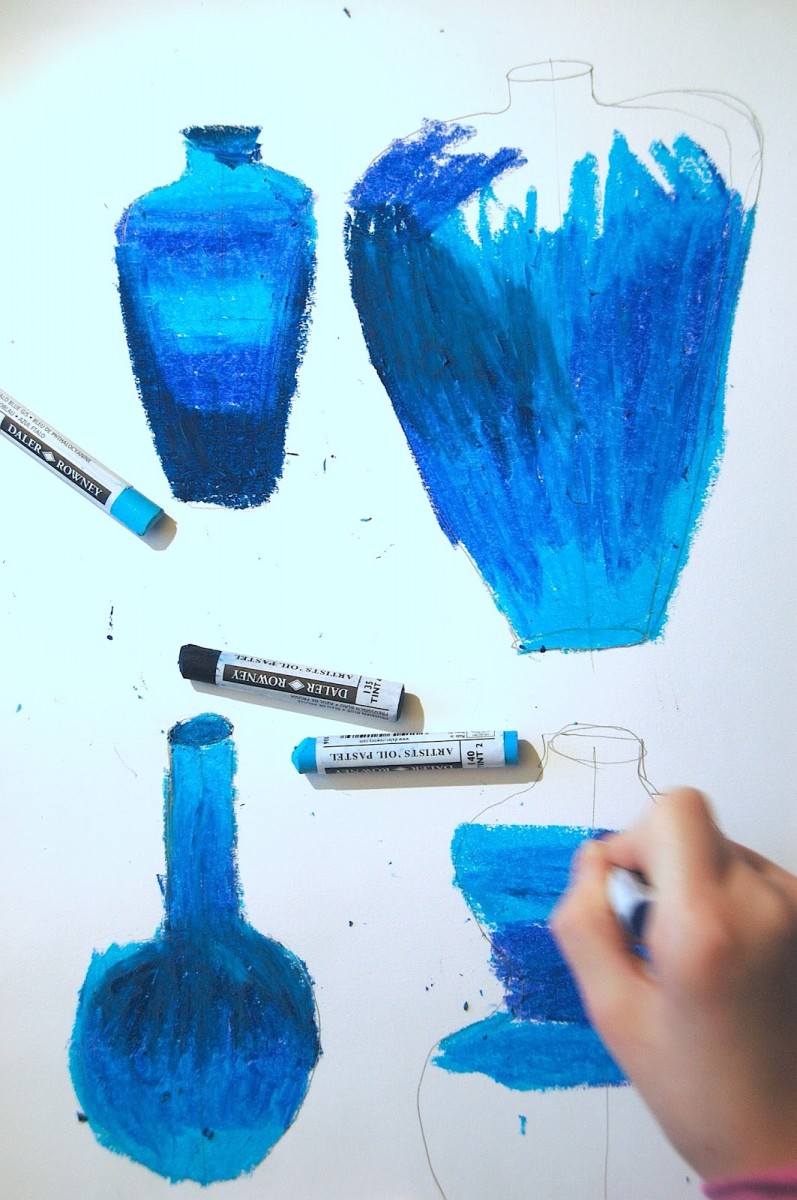

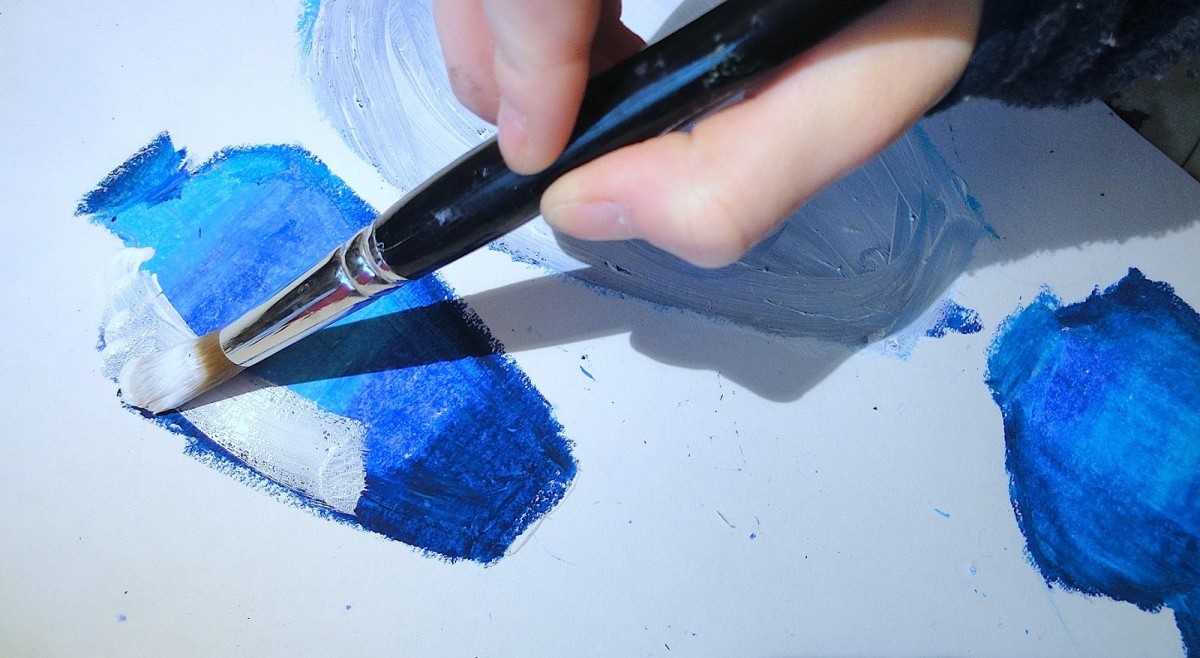











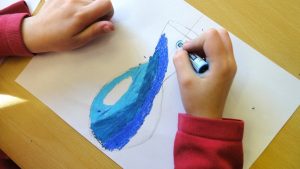



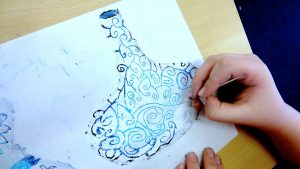


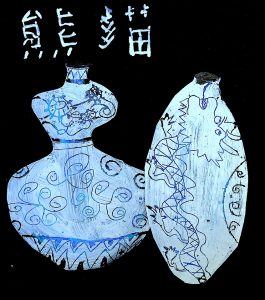






What a great idea! I love the final result, with the various shades coming through. Beautiful!
Idea molto bella, me la sono pinnata! Quando hai tempo ho qualcosa per te: http://mammabook.blogspot.de/2013/01/buon-anno-cominciamo-con-qualche-premio.html
Grazie Silvia! grazie anche del suggerimento del sito, ti seguo in Pinterest e sul tuo Blog! Felice di seguirti e a presto!
Thank you for your comment! The most interesting effect is the shadow behind the white layer, it seems smooth porcelain!
Fantastic! I love the effect of the blue carvings under gesso. Definitely want to try this sometime. Thanks!
Wow! What an ingenius technique- love it all and the effect is so realistic!
Thanks Mary, and the materials and tools are truly available and cheap!
Hi Miss! Thanks for your comment, I appreciate so much!
Hi from Africa! This looks so stunning, would love to try it!
Hi!!! Where are you writing from?? I lived 2 years in Ethiopia and 2 Years in Tanzania… so i really love Africa!!! send me other details of you and your work!! thanks for your comment!
These are just gorgeous! I've done Greek vases the same way with orange covered with black paint, but never thought of this! A whole new world just opened up! Thank you!
Even for me was a discovery! My daughter had to create something about China and I thought to these Greek vases… but white on blue!I've and my daughter enjoyed so much to try different kinds of blue and different media for the white layer (acrylic white paint, white tempera, gesso primer…). And when we would engrave it we began to use nails, pins, spikes, blue pencils, scalpels… then I thought about a simple toothpick! WOW!
Magic : )
Hi Joe!Did you have a nice Christmas holiday? I hope so!! Thanks for your comment and HAPPY ART!
Meravigliosi…tu continua a "produrre" che mi sei d'ispirazione.Io pensavo di far imitare ai ragazzi quelli a figure rosse con il graffito e i pastelli ad olio. Tu hai mai provato? Dici che verrà una schifezza o che potrebbe essere una buona idea? Bacioni Laura
hello there,I am an art teacher from Malaysia and now addicted to you blog!Thank you for sharing. Appreciated!!Have a good day then!!
…Non so, non li ho mai fatti, ma se sono venuti questi con pastelli a olio e acrilico bianco dovrebbe funzionare alla stessa maniera con fondo nero e acrilico rosso oppure con fondo rosso e pittura nera sopra. Può essere un'ottima idea comunque. Ho visto fare i vasi greci con pastelli a cera rossi o gialli sul fondo e china nera sopra, anche questo dovrebbe funzionare… vedi un po' che materiali hai a scuola! Martedì vado alla scuola di Laura e Davide a fare una lezione su questi vasi cinesi nella classe dei più grandi e comincio una collaborazione con la scuola per lavorare nelle classi… ti saprò dire come va! Un abbraccio!
Hi! Nice to meet you! I'm very happy to have contact with you! I'm really interesting in the Art teacher works around the world! keep in touch!
Hi Miriam, I love your blog, just bumped into it recently. The vases are beautiful and such an original idea! I'm an art teacher (american) living in Italy – so it's really quite interesting to see what you do! Since you post in both Eng and Italian, I'm curious what language do you teach in? Come an check us out sometime: http://articulation360.wordpress.com/ it would be great to exchange ideas with you.-Louise
Hi Louise! I’m very glad to know you!! I was teaching in Italian language (in Italy), but now I live in Bristol and I started to do some works at school with my (bad) English… What are you teaching in Italy!? Where are you living?… Sorry, but I’m very curious to know you!!!I visited your blog… it’s amazing!!! I’ll follow you! Keep in touch!
These are fantastic! I love the addition of the shadows for the realistic effect!!!
Thank you Mrs.Chance (is your name Molly?!)I visited your blog and I started to follow your works! Thanks for your comment, I very happy to know other teachers!Keep in touch!
Thanks for the recent comment on my blog. You have wonderful projects here as well. I think I might try this one during the spring. Keep up the great work!
Great! This spring I'll see your work about Ming vases… wow!
This is lovely. My students love to remove the top surface but we have always used black. This is another great technique and they will learn about Ming vases. Thanks so much I will post some photos for you when we complete. You are generous for sharing your ideas and time.
Love your idea and trying project now with my 6th graders. We are having a problem with the gesso peeling off in unwanted areas when they use the toothpick to scrape the design. They are unable to carve out lines/design details. Any solutions????
Did you try with acrylic white paint or tempera? I think You need a different medium instead of gesso, I've also done the project with acrylic white paint and when we carved it with toothpick the layer was not completely dry… perhaps could be better! Tell me if it works, otherwise we can find another solution…
I've found that you could try even acrylic gesso…
We painted with acrylic gesso. It was completely dry. I may have them scrape gently with exacto knives instead of toothpicks. I seem to be getting better results with that on my test project. It could also be that the paint is too thickly painted. We did 2 coats. Thanks
These are beautiful and you're right the materials are so readily available. This idea would also work with Delft pottery.
I love this idea and am using with 8th grade students, although we are also adding collage to make this a mixed-media assignment. Has anyone done this with Greek pottery, as that would probably also look really nice. I will offer that as an option in case some boys want to do that.Thanks again for sharing this wonderful lesson idea! I'm so impressed that you were able to get such great results with 6th graders! Wow.
Thank you for sharing this wonderful lesson idea! I am so impressed with the quality results you achieved with 6th graders. I'm going to try it with 8th grade and also require them to use collage as well to make a mixed-media project. Has anyone tried this with Greek pottery? I may offer that as an option in case any boys would prefer that using red oil pastels under black paint.I did also have some trouble with the white acrylic flaking off in areas I didn't want it to. My best results came from using Scratch board tools to first incise the lines and then use pointed wood scratch art tool to lift out larger shapes and lines.Hope my students like this!!
Do you have them scrape away the Black acrylic over layers of white oil pastels?
La tempera bianca va fatta prima asciugare? Grazie
Ciao Rosanna
è meglio se la tempera è asciutta, però ti consiglio di fare una prova prima per vedere il risultato 👍
Buon lavoro!